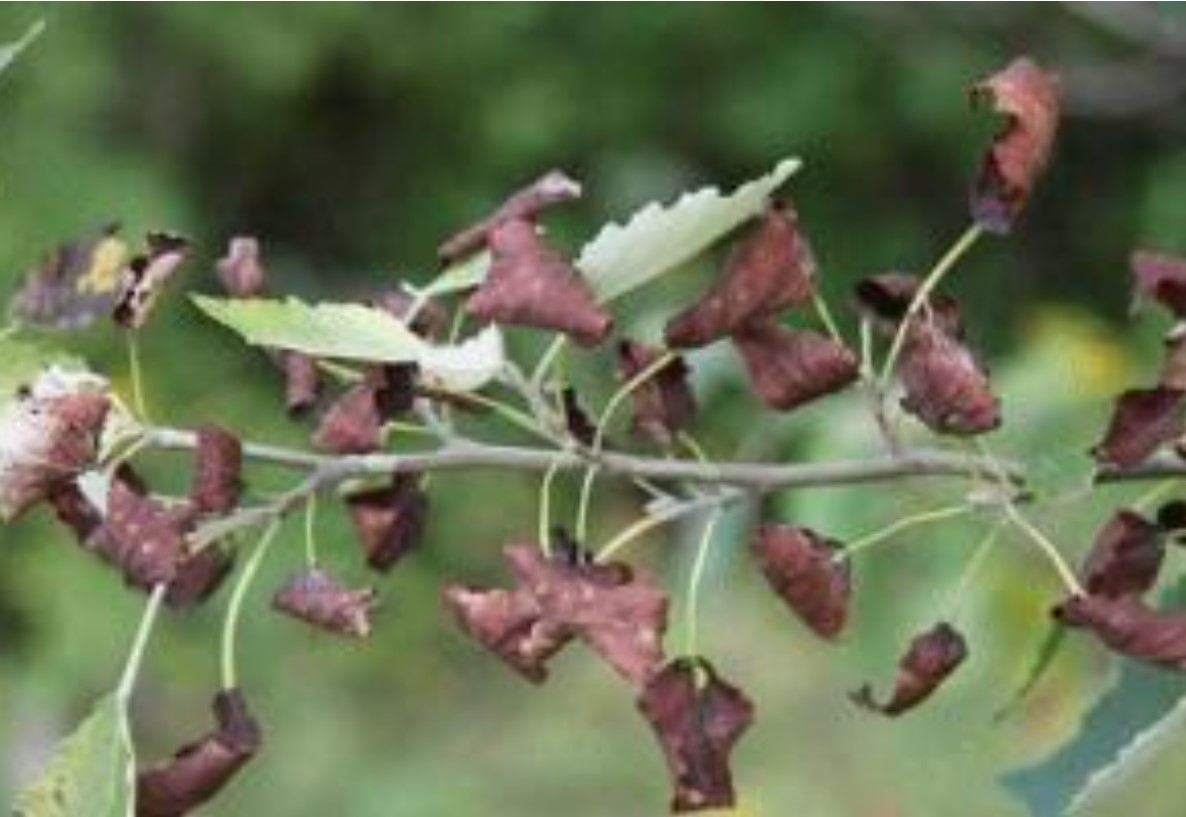Bronze Leaf Disease (BLD) of poplar is caused by the fungus Apioplagiostoma populi. Infection begins through the leaves and becomes systemic, eventually resulting in dieback of the infected tree. Degree of damage that can be expected is difficult to predict since there does seem to be a difference in the degree of susceptibility depending on the species or hybrid of poplar affected. Many native poplar species are susceptible and many poplar hybrids are also known to be susceptible. Some poplar clones such as Tower poplar and Swedish aspen are known to be highly susceptible to the disease.
Sign and Symptoms
Symptoms of this disease first appear in midsummer. Areas of yellowish, orange-brown or reddish-brown discoloration begin near the leaf margins. The discolored areas expand and the discoloration moves toward the leaf base. Veins may appear to remain green for a time and the midrib and petiole may remain green. All the leaves on a shoot may have symptoms. As the infection and the season progress, the affected leaves become bronze in color or a dark reddish brown color and this symptom gives the disease its name. One reference also indicates a chocolate brown color of leaves as symptoms develop. Poplar species may influence symptoms to some degree.
Symptomatic leaves could be scattered throughout the crown of the tree or confined to a few branches, especially in the first year of infection. Symptomatic leaves tend to remain attached to the tree throughout the winter. The fungus moves into the stem and moves systemically in the infected stem resulting in symptom development in other leaves and new developing leaves of growing shoots. New leaves on infected stems may remain underdeveloped. Branch dieback occurs and clones or hybrids that are highly susceptible to the disease can decline and die after several seasons of infection. Trees weakened by BLD will also be more
susceptible to other diseases.
Diagnosis of the disease is based on observation of symptoms as well as examination of symptomatic leaves in late summer and again the following spring to look for the spore producing structures of the fungus. In late summer and fall, fruiting structures called acervuli develop on some infected leaves and in the following spring, fruiting structures called perithecia develop on the overwintered leaves.
Microscope evaluation of overwintered leaves would be necessary to confirm the presence of the disease.
Prevention
Planting
- Avoid planting shelterbelts or ornamental specimens of highly susceptible cultivars in areas where the disease has been identified. The disease has been identified in the Edmonton and Calgary area and is likely present in other parts of the Province Poplar clones Populus x canescens ‘Tower’ (Tower poplar) and P. tremula ‘Erecta’ (Swedish columnar aspen) are known to be highly susceptible. Hybrids between trembling aspen and bigtooth aspen and between bigtooth aspen and white poplar are known to be highly susceptible. The tree supplier should be able to provide information on the parentage of the type of poplar you are considering. The degree of susceptibility for many of these species is not known at this time.
- Avoid dense planting. Space trees to allow airflow and reduce the accumulation of leaf debris.
Sanitation
- For most foliar diseases, sanitation in the form of removal and destruction of fallen leaves is recommended to reduce the source of inoculum. With this disease, sanitation is likely to be of limited value due to the tendency of infected leaves to remain attached to the tree over the winter and into the following spring.
Watering & Fertilizing
- Your trees can be kept healthy by watering and fertilizing. Click here to learn more about watering.
Control - What you need an arborist to do
Chemical Control
- There are no registered chemical controls for Bronze Leaf Disease.
Pruning
- Pruning to thin the tree canopy where shoots are dense would help to improve air circulation in the canopy and thus reduce moisture.

Tree Health Issues
Wondering about costs?

